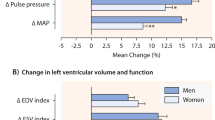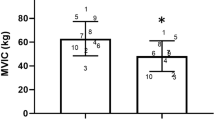Summary
The relationship of sex, age, and body fat content were assessed on the maximal voluntary strength (MVC), the endurance of a sustained contraction held at 40% of the subject's maximal strength, and the associated changes in blood pressure and heart rate. Isometric hand-grip strength was, as expected, greater in men than in women; however, in both sexes, age was inversely related to isometric strength, particularly in women. Body fat content, however, was directly related to strength. In contrast, in both male and female subjects aging was directly related to isometric endurance while body fat content was now inversely related to isometric endurance.
The increase in heart rate throughout a fatiguing contraction at 40% MVC was strikingly similar in men and women. Heart rate, which always increased during exercise, attained its highest magnitude during exercise in the subjects who had the highest resting heart rates. However, older subjects displayed a smaller increase in exercising heart rates than younger subjects.
The blood pressure at the end of the 40% MVC was directly related to the resting blood pressure. However, aging and body fat content both increased the resting systolic blood pressure in men and women; this aging effect was further exaggerated during the exercise.
Similar content being viewed by others
References
Clarke, R. S. J., Hellon, R. F., Lind, A. R.: Duration of sustained contractions of the human forearm at different muscle temperatures. J. Physiol. (Lond.)143, 454 (1958)
Close, R.: Dynamic properties of fast and slow skeletal muscles of the rat during development. J. Physiol. (Lond.)173, 74 (1964)
Drahota, Z., Gutman, E.: Long term influence of the nervous system on some metabolic differences in muscles of different function. Physiol. Bohemoslav.12, 339 (1963)
Elbel, E. R.: The relationship betweel leg strength and other body measurements. J. appl. Physiol.2, 339 (1963)
Gutman, E., Hanzlekova, V.: Age changes in the neuromuscular system, p. 82. Bristol: Scientechnica Ltd. 1972
Hansen, J. W.: Effect of dynamic training of isometric endurance of the elbow flexors. Arbeitsphysiologie23, 367 (1967)
Hermansen, L., Dobeln, W.: Body fat and skinfold measurements. J. clin. Lab. Invest.27, 312 (1971)
Humphreys, P. W., Lind, A. R.: The blood flow through active and inactive muscles of the forearm during sustained handgrip contractions. J. Physiol. (Lond.)166, 120 (1963)
Josenhans, W. C. T.: The isometric exercise performance of men who are overweight. Arbeitsphysiologie19, 173 (1962)
McGlynn, G.: Strength and endurance gains and their relationships. Arbeitsphysiologie26, 323 (1968)
Myers, S. J., Sullivan, W. P.: Effect of circulatory occlusion on time to muscular fatigue. J. appl. Physiol.24, 54 (1968)
Nie, N. D., Bent, D., Hull, C. H.: SPSS. St. Louis: McGraw-Hill 1970
Novak, L.: Aging, total body Kr, fat free mass, and cell mass in males and females between ages 18 and 85 years. J. Geront.27, 438 (1972)
Peterson, F. R., Grandal, H. Hansseb, J. W., Houd, H.: Effect of varying the number of contractions on dynamic muscle training. Arbeitsphysiologie18, 468 (1961)
Petrofsky, J. S., Burse, R. L., Lind, A. R.: Comparison of physiological responses of women and men to isometric exercise. J. appl. Physiol.38, 863 (1975)
Petrofsky, J. S., Lind, A. R.: The relationship of body fat content to deep muscle temperature and isometric endurance. Clin. Sci. molec. Med.48 405 (1975a)
Petrofsky, J. S., Lind, A. R.: Aging, isometric strength and endurance, and cardiovascular responses to static effort. J. appl. Physiol.38, 91 (1975b)
Rohmert, W.: Rechts-links-Vergleich bei isometrischem Armmuskeltraining mit verschiedenem Trainingsreiz bei achtjährigen Kindern. Arbeitsphysiologie26, 363 (1968)
Shephard, R., Kaneko, M., Ishii, K.: Simple indices of obesity. J. Sports Med. Phys. Fitness11, 154 (1971)
Sloan, A. W.: Estimation of body fat in young men. J. appl. Physiol.23, 311 (1967)
Society of Actuaries: Addendum: weights for heights from the Society of actuaries. Stat. Bull. (1959)
Author information
Authors and Affiliations
Rights and permissions
About this article
Cite this article
Petrofsky, J.S., Lind, A.R. Isometric strength, endurance, and the blood pressure and heart rate responses during isometric exercise in healthy men and women, with special reference to age and body fat content. Pflugers Arch. 360, 49–61 (1975). https://doi.org/10.1007/BF00584326
Received:
Issue Date:
DOI: https://doi.org/10.1007/BF00584326




